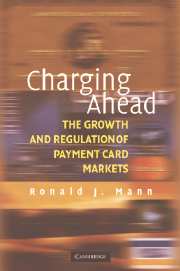Book contents
- Frontmatter
- Contents
- Figures and Tables
- Acknowledgments
- Introduction
- PART I THE BASICS OF PAYMENT CARDS
- PART II EASY MONEY
- PART III THE PUZZLE OF PAYMENT CARDS
- PART IV REFORMING PAYMENT SYSTEMS
- 11 Indirect Approaches: Regulating Interchange and Encouraging Surcharges
- 12 Contract Design
- 13 Regulating Information
- 14 Product Design: Affinity and Rewards Programs and Teaser Rates
- PART V OPTIMIZING CONSUMER CREDIT MARKETS AND BANKRUPTCY POLICY
- Conclusion
- Appendix: Country-Level Data
- Notes
- Bibliography
- Index
14 - Product Design: Affinity and Rewards Programs and Teaser Rates
Published online by Cambridge University Press: 06 July 2010
- Frontmatter
- Contents
- Figures and Tables
- Acknowledgments
- Introduction
- PART I THE BASICS OF PAYMENT CARDS
- PART II EASY MONEY
- PART III THE PUZZLE OF PAYMENT CARDS
- PART IV REFORMING PAYMENT SYSTEMS
- 11 Indirect Approaches: Regulating Interchange and Encouraging Surcharges
- 12 Contract Design
- 13 Regulating Information
- 14 Product Design: Affinity and Rewards Programs and Teaser Rates
- PART V OPTIMIZING CONSUMER CREDIT MARKETS AND BANKRUPTCY POLICY
- Conclusion
- Appendix: Country-Level Data
- Notes
- Bibliography
- Index
Summary
If issuers conceal contract terms related to default, fees, and penalty rates, and avoid meaningful disclosures of account information, on what product features do they compete? The two product features I have chosen to highlight are affinity and rewards programs and teaser rates. Both of those features lower the marginal cost of using a credit card. Both are features on which issuers compete, which clearly attract consumers. Both are terms that consumers probably overestimate in value. Both encourage consumers to spend or borrow more than they otherwise would.
Affinity and Rewards Programs
In the case of an affinity program, the incentive to spend is indirect: the cardholder is motivated by the fact that some portion of the profits or receipts from use of the card will be paid to the affinity sponsor. If the cardholder derives utility from such a payment – a Democrat, for example, might benefit from payments to the Democratic Party from Providian, the issuer of a Democratic Party affinity card – then the gratification gives the cardholder a positive reason for using the card. Rewards programs do the same thing more directly by providing some tangible benefit that is tied to use of the card, such as a cash rebate or airline miles.
- Type
- Chapter
- Information
- Charging AheadThe Growth and Regulation of Payment Card Markets around the World, pp. 167 - 174Publisher: Cambridge University PressPrint publication year: 2006

